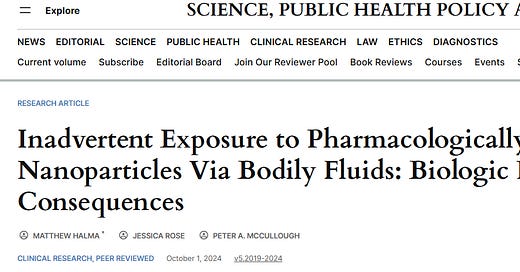Secondary Exposure to COVID-19 Vaccine Components: Communal Iatrogenic Disease?
New peer-reviewed publication poses an important academic question with significant potential clinical implications.
In their latest paper, published in the peer-reviewed journal Science, Public Health Policy & the Law, Halma, Rose, and McCullough (2024) argue that inadvertent secondary exposure to lipid nanoparticles (LNPs), modified mRNA, and spike proteins from COVID-19 vaccines through bodily fluids may present risks to transfusion and transplant recipients. While this topic is controversial, the authors make a compelling case grounded in biological mechanisms, pharmacovigilance data, and case reports, suggesting that this issue merits further investigation.
Biologic Plausibility
The foundation of the paper's argument rests on the well-established concept of biologic plausibility, which, though not conclusive on its own, serves as a necessary precursor to deeper investigations. The persistence of LNPs, spike protein, and possibly modified mRNA in the body for extended periods has been demonstrated in several studies. Given that vaccine components have been detected in the bloodstream for up to 120 days post-injection, it is reasonable to hypothesize that these components could be transferred to transfusion or organ transplant recipients.
Moreover, the similar persistence of spike protein in the breast milk of vaccinated mothers suggests that bodily fluids may serve as a vector for secondary exposure. While the dose of these components is likely lower than that in a primary recipient, the cumulative effect over time or in immunocompromised individuals warrants investigation.
Case Reports and “Pharmacovigilance” Data
Critics may argue that case reports and pharmacovigilance databases are insufficient to establish causality. However, these data are vital for identifying early signals of potential harm, particularly when the adverse events are rare or difficult to detect in controlled trials. VAERS and other databases have recorded an unprecedented number of adverse events related to COVID-19 vaccines, including cardiovascular and thrombotic complications.
While VAERS data should not be used in isolation to determine causality, it is an essential tool for raising safety concerns. The authors' analysis of thrombosis and clotting disorders in recipients of transfusions and transplants from vaccinated donors is consistent with these signals and reinforces the need for further investigation.
Mechanistic Support for Secondary Exposure Risks
The authors provide a thorough review of the potential mechanisms by which vaccine components could persist in the body and be transmitted via bodily fluids. The lipid nanoparticle delivery system, which is crucial for the efficacy of mRNA vaccines, also facilitates the widespread distribution of the mRNA and spike protein throughout the body. Studies showing the presence of these components in exosomes, blood plasma, and even breast milk strengthen the argument that they could be transferred to recipients of transfusions or transplants.
In particular, the data on thrombotic complications in organ transplants from VITT-deceased donors raises legitimate concerns about the long-term safety of such procedures. While VITT is rare, the finding that 30% of recipients experienced thrombotic complications is troubling and cannot be dismissed as an anomaly.
The Precautionary Principle
The paper advocates for further research and passive monitoring to better understand the risks associated with secondary exposure. Critics may argue that there is not yet enough evidence to warrant such steps. However, the precautionary principle—widely accepted in public health—suggests that in cases of potential harm, particularly where there is scientific uncertainty, measures should be taken to mitigate risk.
The voluntary disclosure of vaccination status among blood and organ donors is a minimal intervention that respects individual privacy while allowing for the collection of valuable data. The authors' recommendation for additional hemovigilance and transplant monitoring systems is a reasonable and cost-effective way to address public health concerns.
The Broader Public Health Implications
One of the paper’s most significant contributions is its call for increased awareness of potential risks associated with blood transfusions and organ transplants from vaccinated donors. Public health authorities and policymakers have a responsibility to ensure the safety of medical procedures. Although the evidence presented is preliminary, the possible risks should not be ignored.
By highlighting potential dangers, the paper encourages further research to definitively determine whether vaccine components present a risk through secondary exposure. If these risks are confirmed, proactive steps can be taken to protect vulnerable populations, such as immunocompromised individuals or those undergoing major medical procedures.
Conclusion
Halma, Rose, and McCullough (2024) present a scientifically plausible argument that secondary exposure to COVID-19 vaccine components via bodily fluids could pose risks to transfusion and transplant recipients. While further research is needed to quantify these risks, the biologic mechanisms, pharmacovigilance data, and case reports highlighted in the paper suggest that this issue cannot be dismissed. The authors' recommendations for voluntary disclosure and additional monitoring are prudent and represent responsible public health measures in the face of scientific uncertainty.
Cite this paper
Halma M, Rose J, McCullough P A. 2024. Inadvertent Exposure to Pharmacologically Designed Lipid Nanoparticles Via Bodily Fluids: Biologic Plausibility and Potential Consequences. Science, Public Health Policy and the Law. Oct 01; v5.2019-2024.





I posed this question to all the local regional blood donation product managers four years ago. Aka put them on notice. Their responses were rude or not at all. Good to see someone finally wrote it up and got it published.
What's also concerning to me is the smell that comes out of some vaccine recipients. I smell it a lot in my practice. It's a sweet smell like someone who is going through kidney failure. I realize many docs have spoken about this and the Midwestern Doc on Substack has published a coupla substacks about it, but these vaccines are metabolizing something from their breath and excretory organs. if I am around it too long, I get sick. Are these randomized self-spreading experiments? MRNA documentation by Pfizer explains as much in the safety section for women who are or may become pregnant. Page 67 of the Clinical Protocol docs. Would love to know what it is exactly.